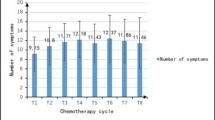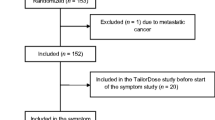Abstract
Purpose
The purpose of this study is to verify that there is a cluster of symptoms in women with breast cancer who were treated with curative intent and are free of disease.
Methods
One hundred and thirty-eight patients were recruited from the Mastology Department of Hospital A.C. Camargo with breast cancer, who have been treated with curative intent and concluded adjuvant chemotherapy 3–24 months prior who may or may not be using hormone therapy. The characterization of the sample was made through descriptive statistics (mean, standard deviation, median, and percentage). For evaluation of the cluster of symptoms, the following were used: Pearson correlation coefficient among the scales of Profile of Mood States, EORTC-QLQ-C30, and EORTC-BR23 and a factor analysis with principal components analysis with promax rotation (oblique). For the extraction of factors, an eigenvalue of 1 was considered, and to evaluate the permanence of symptom factor, a load greater than 0.40 was considered. Statistical significance was defined as p value <0.05.
Results
Through factor analysis of data, three distinct groupings were observed. Factor 1 corresponds to the psychoemotional symptoms and grouped as depression, confusion, anger, tension, fatigue, and breast symptoms. Factor 2 corresponds to physical symptoms, which include pain, dyspnea, arm symptoms, and insomnia. Finally, factor 3 corresponds to gastrointestinal symptoms (inappetence, diarrhea, nausea, and vomiting).
Conclusions
Through the data presented, the cluster of symptoms could be verified in women with breast cancer who were treated with curative intent and free of disease.
Similar content being viewed by others
References
Key TI, Verkasalo PK, Banks E (2001) Epidemiology of breast cancer. Lancet Oncol 2:133–140
Ministério da Saúde, Instituto Nacional de Câncer (2009) Estimativa 2008: incidência de câncer no Brasil. http://www.inca.gov.br/estimativa/2008/versaofinal.pdf. Accessed on 18 Aug 2009
De Angelis R, Tavilla A, Verdecchia A et al (2009) Breast cancer survivors in the United States: geographic variability and time trends, 2005–2015. Cancer 26:112–121
Berry DA, Cronin KA, Plevritis SK et al (2005) Effect of screening and adjuvant therapy on mortality from breast cancer. N Engl J Med 353:1784–1792
Moulder S, Hortobagyi GN (2008) Advances in the treatment of breast cancer. Clin Pharmacol Ther 83:26–36
Courneya KS (2003) Exercise in cancer survivors: an overview of research. Med Sci Sports Exerc 35:1846–1852
Aghili M, Farhan F, Rade MA (2007) Pilot study of the effects of programmed aerobic exercise on the severity of fatigue in cancer patients during external radiotherapy. Eur J Oncol Nurs 11:179–182
Hong S, Bardwell A, Loki N et al (2007) Correlates of physical activity level in breast cancer survivors participating in the Women’s Healthy Eating and Living (WHEL) study. Breast Cancer Res Treat 101:225–232
Barez M, Blasco T, Fernandez-Castro J et al (2009) Perceived control and psychological distress in women with breast cancer: a longitudinal study. J Behav Med 32:187–196
Bernhardson BM, Tishelman C, Rutqvist LE (2008) Self-reported taste and smell changes during cancer chemotherapy. Support Care Cancer 16:275–283
Kim SH, Son BH, Hwang SY, Han et al (2008) Fatigue and depression in disease-free breast cancer survivors: prevalence, correlates, and association with quality of life. J Pain Symptom Manage 35:644–655
Ferlay J, Autier P, Boniol M et al (2007) Estimates of the cancer incidence and mortality in Europe in 2006. Ann Oncol 18:581–592
Okuyama T, Akechi T, Kugaya A et al (2000) Factors correlated with fatigue in disease-free breast cancer patients: application of the Cancer Fatigue Scale. Support Care Cancer 8:215–222
O’Donnell JF (2004) Insomnia in cancer patients. Clin Cornerstone 6:6–14
Bower JE, Ganz PA, Desmond KA et al (2000) Fatigue in breast cancer survivors: occurrence, correlates, and impact on quality of life. J Clin Oncol 18:742–753
Chachaj A, Mayszczak K, Pyszel K et al (2010) Physical and psychological impairments of women with upper limb lymphedema following breast cancer treatment. Psychooncology 19:299–305
Pinto BM, Trunzo JJ (2004) Body esteem and mood among sedentary and active breast cancer survivors. Mayo Clin Proc 79:181–186
Kim H, Barsevick AM, Tulman L et al (2009) Treatment-related symptom clusters in breast cancer: a secondary analysis. J Pain Symptom Manage 36:468–479
Dodd MJ, Miaskowski C, Paul SM (2001) Symptom clusters and their effect on the functional status of patients with cancer. Oncology Nursing Forum 28:465–470
Barsevick AM, Whitmer K, Nail LM et al (2006) Symptom cluster research: conceptual, design, measurement, and analysis issues. J Pain Symptom Manage 31:85–95
Hulley SB, Cummings SR, Browner WS, Grady D, Hearst N, Newman TB (2001) Designing clinical research: an epidemiologic approach, 2nd edn. Williams & Wilkins, Baltimore
Brandão MRF (1996) Perfil Sócio-psicológico da Equipe Nacional de Voleibol Masculino: uma análise à luz da ecologia do desenvolvimento humano. Dissertation. Universidade Federal de Santa Maria, Santa Maria
Sprangers MAG, Groenvold M, Arraras JI et al (1996) The European organization for research and treatment of cancer: breast cancer-specific quality-of-life questionnaire module: first results from a three-country field study. J Clin Oncol 14:2756–2768
Silva FA (2008) Validação e reprodutibilidade de questionários de qualidade de vida específicos para câncer de mama. Dissertation. Fundação Antônio Prudente, São Paulo
Anderson KO, Getto CJ, Mendoza TR et al (2003) Fatigue and sleep disturbance in patients with cancer, patients with clinical depression, and community-dwelling adults. J Pain Symptom Manage 25:307–318
Gärtner R, Jensen M, Nielsen J et al (2009) Prevalence of and factors associated with persistent pain following breast cancer surgery. JAMA 302:1985–1992
Jung BF, Herrmann D, Griggs J et al (2005) Neuropathic pain associated with nonsurgical treatment of breast cancer. Pain 118:10–14
Grond S, Zech D, Diefenbach C et al (1994) Prevalence and pattern of symptoms in patients with cancer pain: a prospective evaluation of 1635 cancer patients referred to a pain clinic. J Pain Symptom Manage 9:372–382
Dolbeault S, Cayrou S, Bredart A et al (2009) The effectiveness of a psycho-educational group after early-stage breast cancer treatment: results of a randomized French study. Psychooncology 18:647–656
Stanton AL, Ganz PA, Kwan L et al (2005) Outcomes from the moving beyond cancer psychoeducational, randomized, controlled trial with breast cancer patients. J Clin Oncol 23:6009–6018
Tiedtke C, Rijk A, Casterle D et al (2009) Experiences and concerns about returning to work' for women breast cancer survivors: a literature review. Psychooncology 12:345–357
Logan V (1995) Incidence and prevalence of lymphoedema: a literature review. J Clin Nurs 4:213–219
Sagen A, Kåresen R, Sandvik L et al (2009) Changes in arm morbidities and health-related quality of life after breast cancer surgery—a five-year follow-up study. Acta Oncol 27:1–8
Knobf MT (2006) The influence of endocrine effects of adjuvant therapy on quality of life outcomes in younger breast cancer survivors. Oncologist 11:96–110
Bender CM, Ergun F, Rosenzweig MQ et al (2005) Symptom clusters in breast cancer across 3 phases of the disease. Cancer Nurs 28:219–225
Bower E, Ganz PA, Desmond KA et al (2001) Fatigue in breast cancer survivors: occurrence, correlates, and impact on quality of life. J Clin Oncol 18:743–753
Given B, Given CW, Azzouz F (2001) Physical functioning of elderly cancer patients prior to diagnosis and following initial treatment. Nurs Res 50:222–232
Kim HJ, Barsevick AM, Tulman L (2001) Predictors of the intensity of symptoms in a cluster in patients with breast cancer. J Nurs Scholarsh 41:158–165
Sarna L, Brecht ML (1997) Dimensions of symptom distress in women with advanced lung cancer: a factor analysis. Heart Lung 26:23–30
Author information
Authors and Affiliations
Corresponding author
Rights and permissions
About this article
Cite this article
Evangelista, A.L., Santos, E.M.M. Cluster of symptoms in women with breast cancer treated with curative intent. Support Care Cancer 20, 1499–1506 (2012). https://doi.org/10.1007/s00520-011-1238-1
Received:
Accepted:
Published:
Issue Date:
DOI: https://doi.org/10.1007/s00520-011-1238-1




